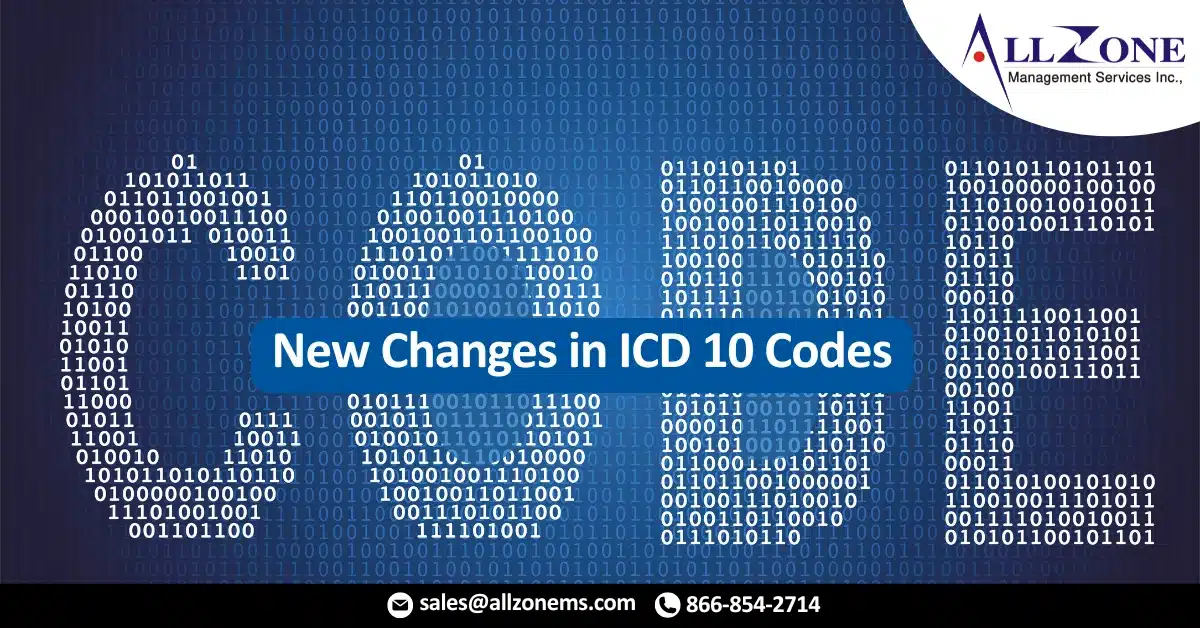As per new update in medical coding, their will again some new ICD 10 codes in FY 2020. Also, their will some deletion and revision of ICD 10 codes.
Their are around 273 new codes, 21 deleted codes, and 30 code title revisions for Year 2020. The new changes are as per the Proposed Inpatient Prospective Payment System (IPPS) Rule, which was published on April 23, 2019.
Chapter Wise New ICD 10 Codes Added 2020
- Diseases of the blood and blood-forming organs and certain disorders involving the immune mechanism (D50-D89) – 5
- Diseases of the ear and mastoid process (H60-H95) – 1
- Diseases of the circulatory system (I00-I99) – 30
- Diseases of the skin and subcutaneous tissue (L00-L99) – 25
- Diseases of the genitourinary system (N00-N99) – 3
- Congenital malformations, deformations and chromosomal abnormalities (Q00-Q99) – 31
- Symptoms, signs and abnormal clinical and laboratory findings, not elsewhere classified (R00-R99) – 3
- Injury, poisoning and certain other consequences of external causes (S00-T88) – 87
- External causes of morbidity (V00-Y99) – 75
- Factors influencing health status and contact with health services (Z00-Z99) – 13
Specific ICD 10 Codes Changes in 2020
In 2020, their will four new atrial fibrillation codes and two existing codes (I48.1, I48.2) have been deleted.
Specific codes for these lower extremity veins have also been added to subcategories:
- Acute embolism and thrombosis of deep veins of lower extremity
- Chronic embolism and thrombosis of deep veins of lower extremity
Category L89, Pressure ulcer, has been expanded with a sixth character of “6” which indicates pressure-induced deep tissue damage of various anatomic sites.
Several codes have ben added to category Q66, Congenital deformities of feet, to provide specificity for laterality
Several new subcategories have been added to specify fractures of the orbital roof and individual orbital walls frequently seen in facial trauma cases. Poisoning codes have been added for poisoning by multiple medicaments (T50.91-) and heatstroke/sunstroke (T67.0-). Injury codes have been increasing every year. I think the most specific codes can be found in this chapter only. This year again their are around 87 new ICD 10 codes only for this chapter.
Highlights Of Some New ICD 10 Codes Of 2020
- Eye wall fractures.Sixty new acute fracture codes for closed and open fractures of the orbital wall surrounding the eye, specific to laterality and position around the eye. Example: New code 831Bwill report fracture of medial orbital wall right side, initial encounter for open fracture.
- Deep tissue injuries.A total of 25 new codes are proposed to be added to specifically capture deep tissue injuries, such as 026 (Pressure-induced deep tissue damage of left elbow) and L89.156(Pressure-induced deep tissue damage of sacral region). Deep tissue injuries currently are coded as unstageable pressure ulcers, which is incorrect by definition, according to the proposal. These codes were originally proposed at the ICD-10 Coordination & Maintenance Committee meeting in September 2018.
- Atrial fibrillation.Four new codes in the – category are proposed to capture different forms of persistent and chronic atrial fibrillation, such as I48.11 (Longstanding persistent atrial fibrillation) and I48.21 (Permanent atrial fibrillation).
- Phlebitis and thrombophlebitis.Eight new codes for phlebitis and thrombophlebitis that will allow more specific coding for laterality and location, such as 241 (Phlebitis and thrombophlebitis of right peroneal vein).
- Embolism and thrombosis.New codes to allow reporting of chronic embolism and thrombosis of the peroneal vein and calf muscular vein as well as new codes for acute embolism and thrombosis of those veins. The codes will also be selected based on laterality. For example: Code 451 describes acute embolism of right peroneal vein, while I82.562 describes chronic embolism and thrombosis of left calf muscular vein.
- Poisoning, adverse effects and underdosing. The proposed update includes 18 new T codes for poisoning, adverse effects or underdosing of multiple unspecified drugs, medicaments and biological substances. You’ll use the appropriate seventh character to describe the encounter: initial, subsequent or sequela. The new poisoning codes are divided into four causes: accidental, intentional, assault and undetermined. For example, 913S(Poisoning by multiple unspecified drugs, medicaments and biological substances, assault, sequela).
- Summer will be over when the new codes go live, but you’ll have options for heatstroke and sunstroke (T67.01X-), exertional heatstroke (T67.02X-), and other heatstroke and sunstroke (T67.09X-).
- Legal intervention.There will be 75 new codes for injuries sustained during a legal intervention. Many of the additions are to be used to indicate that an unspecified person was injured. For example, 319A (Legal intervention involving baton, unspecified person injured, initial encounter). The current code set describes injuries to law enforcement officers, bystanders or suspects. In addition, there are new codes for injuries caused by conducted energy devices, such as tasers. Codes Y35.831A-Y35.839S describe injuries to law enforcement officials, bystanders, suspects or unspecified individuals.
- New Z codes.You’ll find a handful of new codes for factors influencing health status and contact with health services. Proposed codes include 020 (Encounter for examination of eyes and vision following failed vision screening without abnormal findings), Z22.7 (Latent tuberculosis), six new personal history of in-situ neoplasms codes (Z86.002-Z86.007) and one code for the presence of a neurostimulator (Z96.82).
Revisions
- Codes under 906-(Underdosing of unspecified psychodysleptics) and T40.996- (Underdosing of other psychodysleptics) were revised to include the term “[hallucinogens]” in the title.
- Codes under 1×6-(Underdosing of other parasympathomimetics) were revised to include the term “cholinergics” in the title.
- Codes 51(Other enthesopathy of right foot) and M77.52 (Other enthesopathy of left foot) were revised to include the terms “and ankle” in the title.
For More Information: https://www.americanmedicalcoding.com/new-changes-icd-10-codes-2020/

